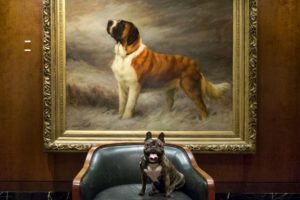Art of Dogs

Learning Objectives
Students will compare two representations of dogs in a painting and a poem, noting the differences and similarities in the two representations, with reference to the time period within which each work was created.
Grade Levels
9-10
Common Core Standards
RL.9-10.7
Analyze the representation of a subject or a key scene in two different artistic mediums, including what is emphasized or absent in each treatment.
Materials Needed
Student copies of Saved by Sir Edwin Henry Landseer, or images below shown on a screen
Saved, by Sir Edwin Henry Landseer This is the Currier and Ives print titled He Is Saved.
Saved, by Sir Edwin Henry Landseer
Student copies of To Flush, My Dog by Elizabeth Barrett Browning, or one copy shown on screen for the whole class
Lesson
Introduction
- Review students’ prior knowledge of Victorian era paintings and poems, and Victorian ideals.
- Explain that today’s work will be to compare two different representations of dogs in Victorian era works of art, one a poem and the other a painting.
Explicit Instruction/Teacher Modeling
- Give students time to read the poem and look at the painting.
- Stop frequently to discuss unfamiliar words such as, “ringlets,” “demurely,” “burnished,” “curvetting,” “moor,” “languid,” “hieing.” “arointed,”
- To Flush, My Dog was published in 1844, and Saved was painted in 1856. This is in the middle of the Victorian era.
Independent Working Time
- Ask students to discuss with a partner how the dogs are represented in each work of art.
- Circulate and check for comprehension.
- Students complete a T-chart comparing the representation of dogs in each work, considering the following questions: How are the dogs represented in each work of art? What character traits does each dog embody? What are the similarities in each representation? The differences?
Review and Closing
- Students share with other partner pairs their observations of how dogs are represented in each work of art.
- Focus student attention on the similarity of romantic tone in both the poem and painting. In both, the dogs are portrayed with human characteristics that fit the feminine Victorian ideals of loyalty, self-sacrifice, duty and love.
- Note the differences in the two representations, as well, that in the painting the dog is the hero and rescuer, and in the poem the dog is the companion and friend to the author.
- Students who would like to know more about the breeds in these works of art may wish to visit English Cocker Spaniel and Newfoundland and Saint Bernard for more information.
Extension
- Review students’ prior knowledge of the Victorian ideals for women. (The Angel in the House, self-sacrificing, loyal, self-effacing)
- Refocus students’ attention and offer the following topic for discussion:
- How does the portrayal of the dogs in these works of art compare to the Victorian ideal for women?
- Students work with partners to describe how the representations of dogs are similar to and different from the Victorian ideal for women.
- Note that Elizabeth Barrett Browning was a proponent of Women’s Rights, and an admirer of Mary Wollstonecraft, who wrote A Vindication of the Rights of Women.
Resources
Ideals of Womanhood in Victorian Britain. (September 18, 2014). Retrieved from https://www.bbc.co.uk/history/trail/victorian_britain/women_home/ideals_womanhood_01.shtml
Edwin Henry Landseer: 19th-Century Britain’s Foremost Animal Painter. (April 17, 2015). Retrieved from https://www.mimimatthews.com/2015/04/17/edwin-henry-landseer-19th-century-britains-foremost-animal-painter/
He is Saved, Currier & Ives. (n.d.). Retrieved from https://springfieldmuseums.org/collections/item/he-is-saved-currier-ives/
A Short Analysis of Elizabeth Barrett Browning’s ‘To Flush, My Dog’. (February 18, 2018). Retrieved from https://interestingliterature.com/2018/02/18/a-short-analysis-of-elizabeth-barrett-brownings-to-flush-my-dog/

